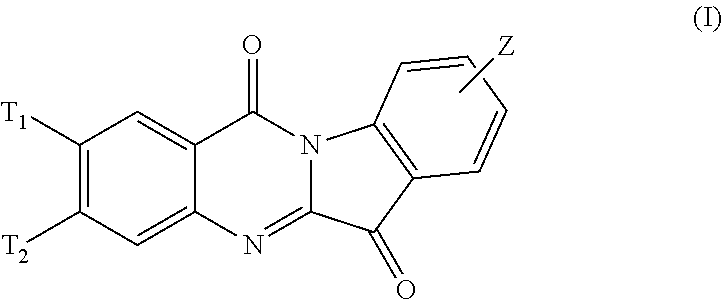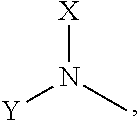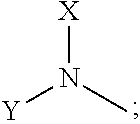N-alkyl tryptanthrin derivative, preparation method for same, and application thereof
a technology of nalkyl tryptanthrin and derivative, applied in the field of medicinal chemistry, can solve the problem of insufficient development of tryptanthrin compounds, and achieve the effect of novel structure and high effectiveness
- Summary
- Abstract
- Description
- Claims
- Application Information
AI Technical Summary
Benefits of technology
Problems solved by technology
Method used
Image
Examples
example 1
[0068]
[0069]Compound 1 (500 mg, 2.2 mmol) was suspended in 10 ml of dry methylene chloride. Under 0° C., meta-chloroperoxybenzoic acid (0.76 g, 4.4 mmol, 85%) was added portion wise. The reaction mixture was stirred for 2 hours under room temperature. After the reaction was monitored as being completed by TLC (CH2Cl2 / MeOH=50 / 1, Rf 0.4), the formed white solid was filtered and washed with ethyl acetate (10 ml) for three times to Rive compound 2 (420 mg, 79%).
[0070]The mixture of compound 2 (3 g, 12.4 mmol), 5-fluoro isatin (2 g, 12.4 mmol) and triethylamine (3.6 ml, 24.8 mmol) was suspended in dry methylbenzene (12 ml) and was warmed under 110° C. for 4 hours. The solvent was removed under reduced pressure. The yellow solid was dissolved in dichloromethane (2 ml), and then ethyl acetate (2 ml) was added. The obtained yellow solid was filtered and washed with ethyl acetate (2 ml) for three times to give compound 3 as yellow solid (1.9 g, 44%).
[0071]1H NMR (400 MHz, DMSO) δ8.49 (s, 1H)...
example 2
[0076]
[0077]Under the protection of nitrogen, Compound 3 (100 mg, 0.29 mmol), N-Methylpiperazine (58 mg, 0.58 mmol), Pd(OAc)2 (palladium acetate, 20 mg, 0.087 mmol), BINAP ((±)-2,2′-bis-(diphenylphosphino)-1,1′-binaphthyl, 84 mg, 0.14 mmol) and Cs2CO3 (189 mg, 0.58 mmol) were suspended in anhydrous methylbenzene (5 ml) and warmed under 110° C. for 16 hours. After monitored as the reaction was completed by TLC (CH2Cl2 / MeOH=15 / 1, Rf 0.4), the solvent was removed under reduced pressure. Dichloromethane (20 ml) was added into the obtained black solid, washed with water and saline and dried. The black soild obtained by concentration was separated by silicagel column (CH2Cl2 / MeOH=15 / 1) to give compound 6 as red solid.
[0078]1H NMR (400 MHz, CDCl3) δ8.64 (dd, J=8.8, 4.1 Hz, 1H), 7.90 (d, J=9.1 Hz, 1H), 7.76 (d, J=2.9 Hz, 1H), 7.57 (dd, J=6.6, 2.7 Hz, 1H), 7.47 (td, J=8.7, 2.7 Hz, 1H), 7.39 (dd, J=9.1, 3.0 Hz, 1H), 3.57-3.43 (m, 4H), 2.69-2.57 (m, 4H), 2.40 (s, 3H).
example 3
[0079]
[0080]Under the protection of nitrogen, Compound 3 (100 mg, 0.29 mmol), dimethylamine hydrochloride (246 mg, 2.9 mmol), Pd(OAc)2 (20 mg, 0.087 mmol), BINAP (84 mg, 0.14 mmol) and Cs2CO3 (1.1 g, 3.48 mmol) were suspended in anhydrous methylbenzene (5 ml) and warmed under 110° C. for 16 hours. After the reaction was monitored as being completed by TLC (CH2Cl2 / MeOH=15 / 1, Rf 0.4), the solvent was removed under reduced pressure. The obtained black solid was added into dichloromethane (20 ml), washed with water and saline, and dried with anhydrous sodium sulfate. The black solid obtained after concentration was separated by silicagel column (CH2Cl2 / MeOH=15 / 1) to give a red solid compound 7 (22 mg, 25%).
[0081]1H NMR (400 MHz, CDCl3) δ8.61 (dd, J=8.8, 4.0 Hz, 1H), 7.85 (d, J=9.1 Hz, 1H), 7.55 (dd, J=6.7, 2.6 Hz, 1H), 7.50 (d, J=2.9 Hz, 1H), 7.44 (td, J=8.7, 2.6 Hz, 1H), 7.15 (dd, J=9.1, 3.0 Hz, 1H), 3.18 (s, 6H).
PUM
| Property | Measurement | Unit |
|---|---|---|
| Structure | aaaaa | aaaaa |
Abstract
Description
Claims
Application Information
 Login to View More
Login to View More - R&D
- Intellectual Property
- Life Sciences
- Materials
- Tech Scout
- Unparalleled Data Quality
- Higher Quality Content
- 60% Fewer Hallucinations
Browse by: Latest US Patents, China's latest patents, Technical Efficacy Thesaurus, Application Domain, Technology Topic, Popular Technical Reports.
© 2025 PatSnap. All rights reserved.Legal|Privacy policy|Modern Slavery Act Transparency Statement|Sitemap|About US| Contact US: help@patsnap.com



